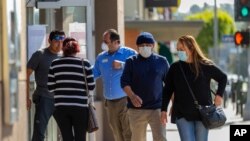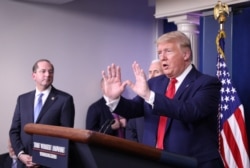All Americans should wear nonmedical masks to help prevent the spread of COVID-19, the U.S. government is recommending.
The new guidelines, from the U.S. Centers for Disease Control and Prevention amid the coronavirus pandemic, were announced Friday by President Donald Trump.
Trump stressed the recommendation was voluntary and said he would not be following it.
“You can do it. You don’t have to do it. I’m choosing not to do it,” he told reporters.
“Somehow, sitting in the Oval Office behind that beautiful Resolute Desk, wearing a face mask as I greet presidents, prime ministers, dictators, kings, queens — I just don’t see it,” Trump elaborated.
Some lack symptoms
The U.S. surgeon general, Dr. Jerome Adams, said donning the masks was, however, a good idea to try to prevent the virus from spreading, since many infected with it do not show any symptoms.
“We now know from recent studies that a significant portion of individuals with coronavirus lack symptoms,” he said. “This means that the virus can spread between people interacting in close proximity — for example, coughing, speaking or sneezing.”
The president and other officials stressed that people should not use the medical-grade masks, which are in short supply and needed by first responders and health professionals.
“The CDC is recommending that Americans wear a basic cloth or fabric mask that can be either purchased online or simply made at home,” Trump said.
He also announced that he was invoking the Defense Production Act to halt the export of “scarce health and medical supplies by unscrupulous actors and profiteers.”
“We need these items immediately for domestic use,” Trump said. “We have to have them.”
Canada, meanwhile, warned the Trump administration about halting the supply of masks to its neighbor and ally.
“The level of integration between our economies goes both ways across the border,” Canadian Prime Minister Justin Trudeau said Friday. “It would be a mistake to create blockages or reduce the amount of back-and-forth trade of essential goods and services, including medical goods, across our border. That is the point we’re making to the American administration right now.”
Canada will “pull out all the stops” to prevent the United States from blocking the exports of some medical equipment, Deputy Prime Minister Chrystia Freeland said.
Warning from 3M
A major manufacturer of the N95 respirators was also upset about the Trump administration’s action.
There are “significant humanitarian implications of ceasing respirator supplies to health care workers in Canada and Latin America, where we are a critical supplier of respirators,” 3M, a Minnesota-based multinational conglomerate, said in a statement Friday. “In addition, ceasing all export of respirators produced in the United States would likely cause other countries to retaliate and do the same, as some have already done. If that were to occur, the net number of respirators being made available to the United States would actually decrease.”
"I don’t blame ‘em — they can push back if they want,” Trump said when asked by VOA about the company’s comment. “We’re not happy with 3M.”
The pandemic has yet to peak in the United States, amid an estimation by the White House that 100,000 to 240,000 people in the country could die of the new coronavirus in the next couple of months, even if social distancing was strictly followed.
The response coordinator for the White House coronavirus task force, Dr. Deborah Birx, said the numbers go could higher if there was another big outbreak in a major metropolitan area similar to the one in New York City.
She noted officials were continuing to watch the situation in Detroit and Chicago and expressed new concern about the states of Colorado and Pennsylvania, as well as Washington, D.C.
“The models show hundreds of thousands of people are going to die” in the United States, the president said. “I want much less than that. I want none. But it’s too late for that.”
Biggest jump
New York state registered its biggest single-day increase in COVID-19 deaths and hospitalizations, Governor Andrew Cuomo said.
He said 562 people had died of the virus in the last 24 hours, adding that there were more than 100,000 confirmed infections in the state.
This is the “highest single increase in the number of deaths since we started,” he said Friday.
Looking ahead, in the near term, Cuomo warned that more people were going to die in hospitals because of a lack of ventilators.
New York is the epicenter of the outbreak in the United States, the country with the most COVID-19 cases. As of Friday, according to Johns Hopkins University, there were more than 275,000 COVID-19 cases in the country, with deaths in excess of 7,000.
The virus was projected to become the top killer in the country on peak days this month, according to a daily tracker set up by an organization of assisted-living facilities.
The economic health of the nation also is in jeopardy. Economists are forecasting the U.S. unemployment rate soon will surpass levels seen during the global financial crisis 12 years ago.
A total of 701,000 jobs were lost last month, according to the U.S. Labor Department, but its data did not include those Americans who lost employment in the past two weeks and filed claims.
"The devastating news in the March jobs report demands our next step be to go bigger and further assisting small business, to go longer in unemployment benefits and to provide additional direct payments,” House Speaker Nancy Pelosi said in a statement after the Friday release of the Labor Department number.
“We must also provide the desperately needed resources for our hospitals, health systems, health workers and state and local governments on the front lines of this crisis,” she said.
Hardships to increase
White House economic officials said they would not sugarcoat the damage that the pandemic was doing to the U.S. economy.
“The whole pandemic and its consequences have come on exponentially faster” than anyone expected, Larry Kudlow, director of the U.S. National Economic Council, told reporters Friday at the White House. “Those numbers and those hardships are going to get worse before they get better.”
Loans backed by the U.S. government began going out on Friday to small businesses so they could keep workers on their payrolls amid a widespread shutdown of the economy because of stay-at-home orders in a majority of states.
The White House also announced Friday that anyone who is expected to be in close proximity to either the president or Vice President Mike Pence “will be administered a COVID-19 test to evaluate for pre-symptomatic or asymptomatic carriers’ status to limit inadvertent transmission.”
The tests were to be initiated on Friday. Journalists in the room for the coronavirus task force briefing were not tested, indicating that close proximity apparently means those who may come within a distance of a meter or two of Trump or Pence.








